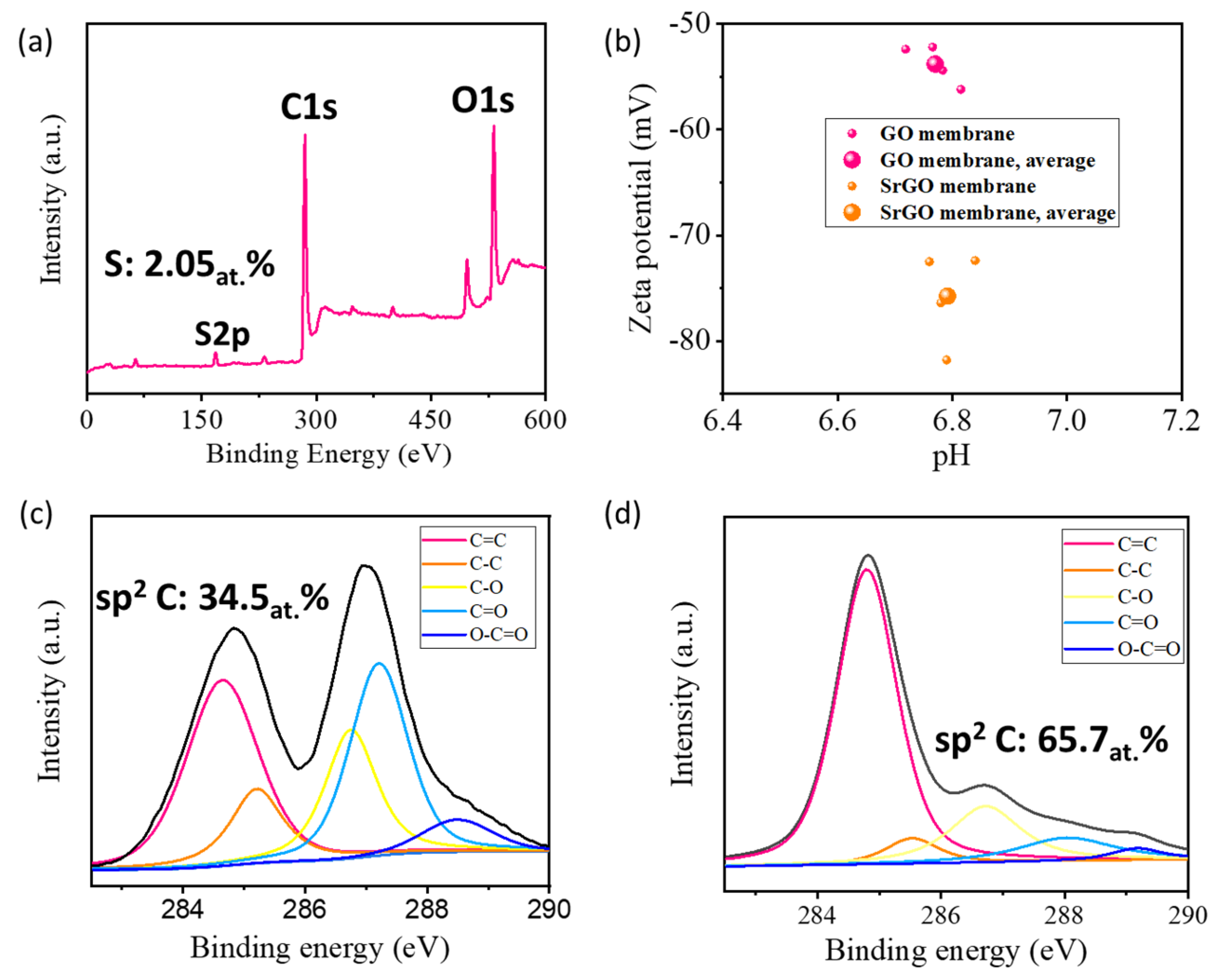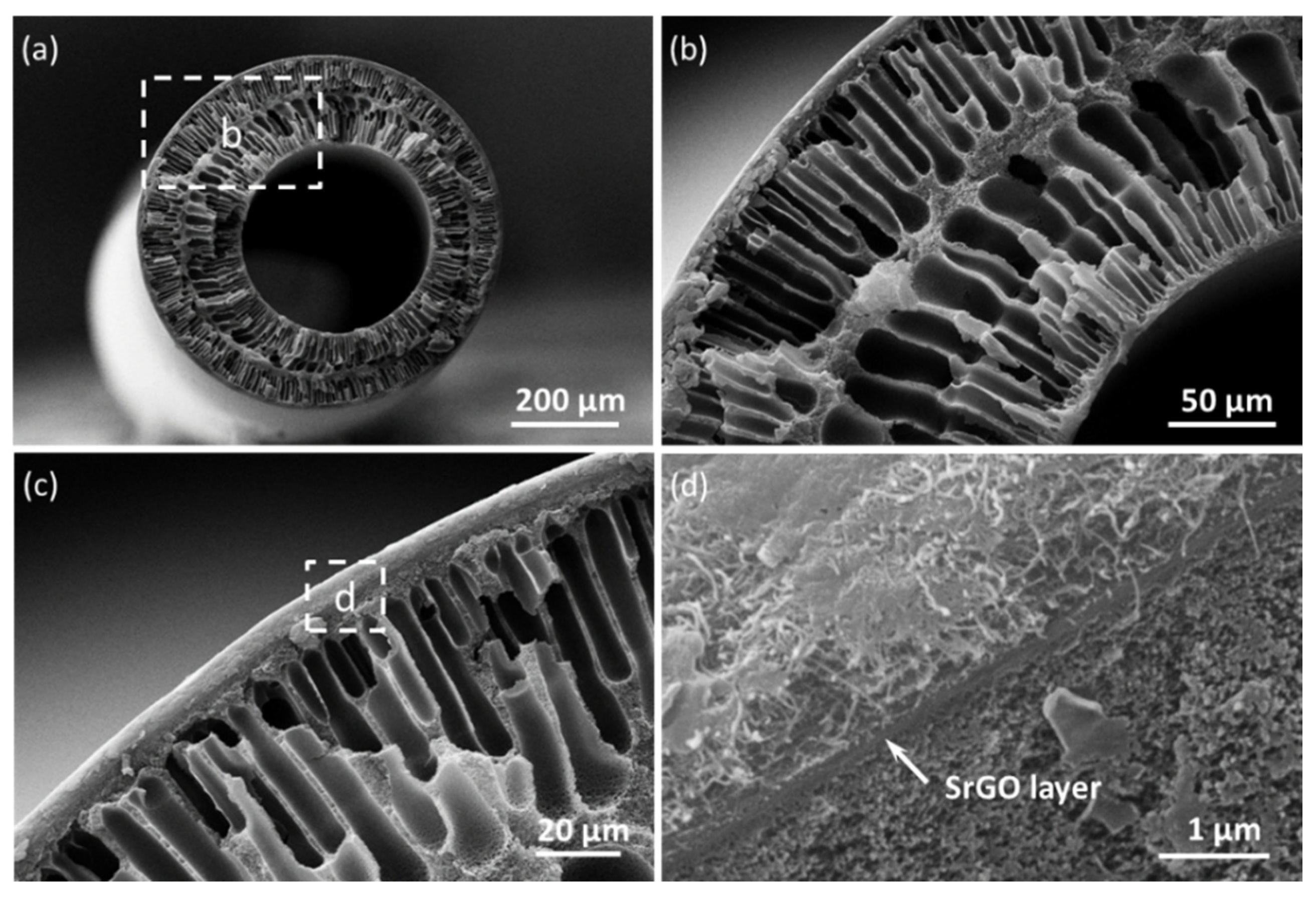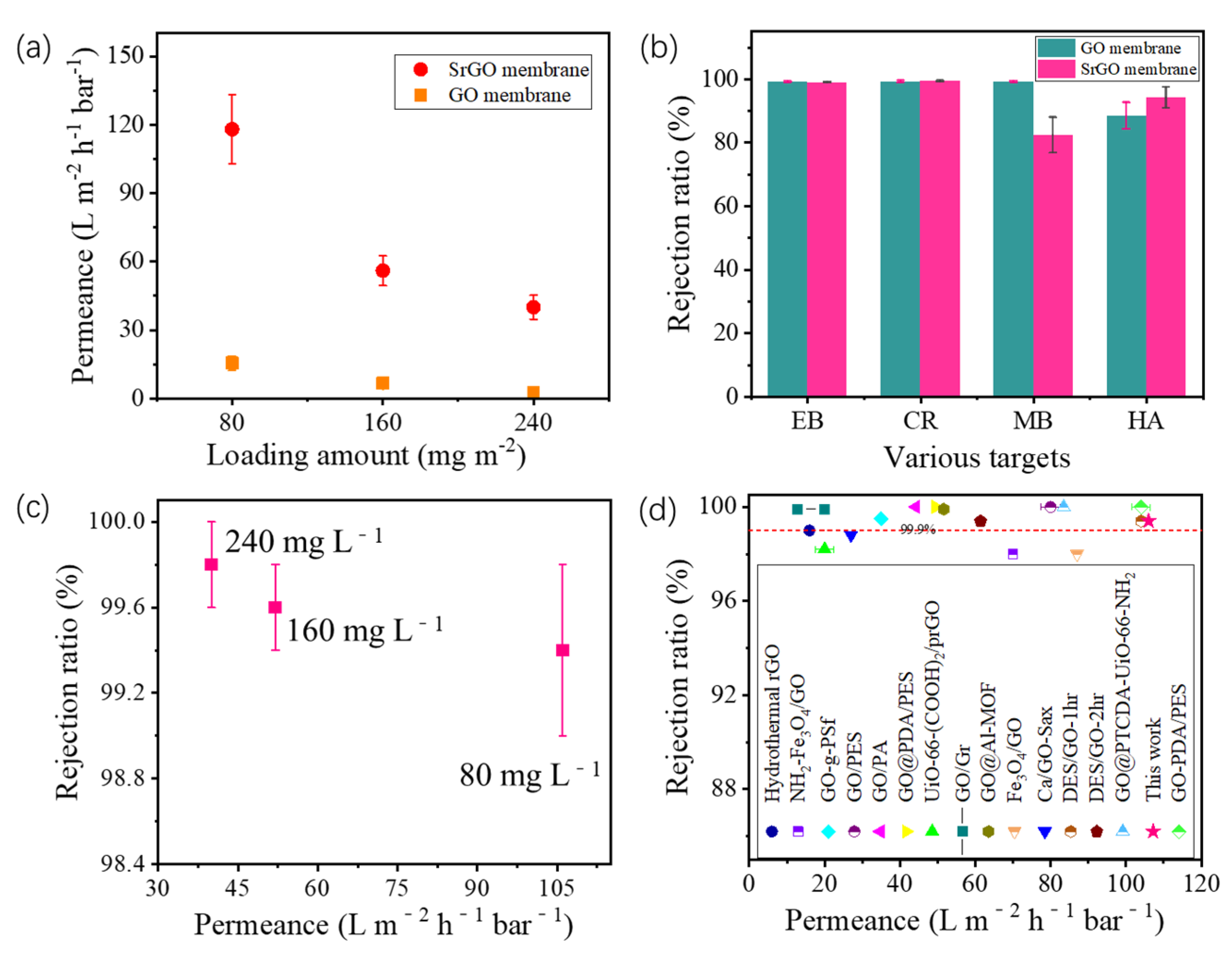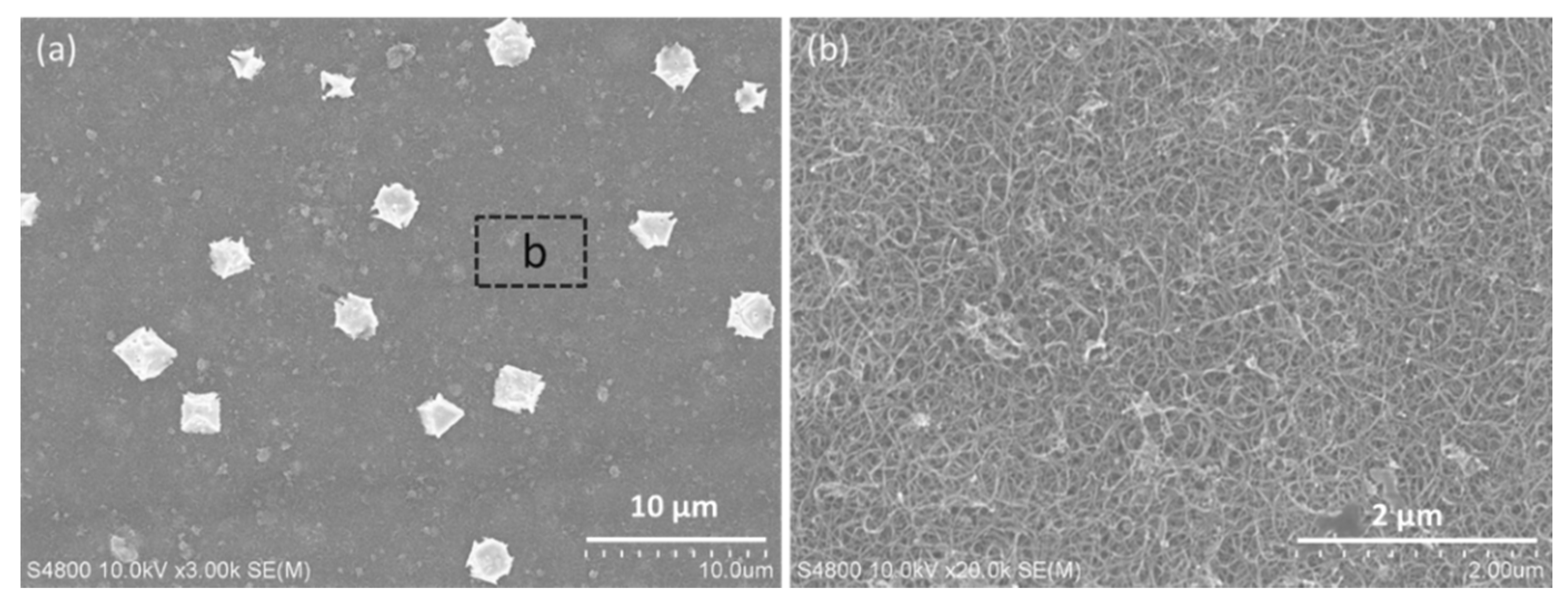Highly Permeable Sulfonated Graphene-Based Composite Membranes for Electrochemically Enhanced Nanofiltration
Abstract
:1. Introduction
2. Materials and Methods
2.1. Materials
2.2. Preparation of SrGO-Based Composite Membranes
2.3. Characterization
2.4. Performance Evaluation of SrGO Membranes
3. Results
3.1. Characterization of SrGO Membranes
3.2. Separation Performance of SrGO Membranes
4. Discussion
5. Conclusions
Supplementary Materials
Author Contributions
Funding
Institutional Review Board Statement
Informed Consent Statement
Data Availability Statement
Conflicts of Interest
References
- Chen, L.; Li, N.; Wen, Z.; Zhang, L.; Chen, Q.; Chen, L.; Si, P.; Feng, J.; Li, Y.; Lou, J.; et al. Graphene oxide based membrane intercalated by nanoparticles for high performance nanofiltration application. Chem. Eng. J. 2018, 347, 12–18. [Google Scholar] [CrossRef]
- Koros, W.; Zhang, C. Materials for next-generation molecularly selective synthetic membranes. Nat. Mater. 2017, 16, 289–297. [Google Scholar] [CrossRef] [PubMed]
- Goh, P.; Ismail, A. Review: Is interplay between nanomaterial and membrane technology the way forward for desalination? J. Chem. Technol. Biotechnol. 2015, 90, 971–980. [Google Scholar] [CrossRef]
- Fane, A.G.; Wang, R.; Hu, M.X. Synthetic membranes for water purification: Status and future. Angew. Chem. Int. Ed. 2015, 54, 3368–3386. [Google Scholar] [CrossRef]
- Li, T.; Shang, D.W.; Gao, S.W.; Wang, B.; Kong, H.; Yang, G.Z.; Shu, W.D.; Xu, P.L.; Wei, G. Two-dimensional material-based electrochemical sensors/biosensors for food safety and biomolecular detection. Biosensors 2022, 12, 314. [Google Scholar] [CrossRef]
- He, J.Y.; Xu, P.L.; Zhou, R.F.; Li, H.; Zu, H.L.; Zhang, J.; Qin, Y.B.; Liu, X.H.; Wang, F.Y. Combustion synthesized electrospun inzno nanowires for ultraviolet photodetectors. Adv. Electron. Mater. 2021, 8, 2100997. [Google Scholar] [CrossRef]
- Li, H.; Xu, P.L.; Liu, D.; He, J.Y.; Zu, H.L.; Song, J.J.; Zhang, J.; Tian, F.H.; Yun, M.J.; Wang, F.Y. Low-voltage and fast-response SnO2 nanotubes/perovskite heterostructure photodetector. Nanotechnology 2021, 32, 375202. [Google Scholar] [CrossRef]
- Mi, B.X. Graphene oxide membranes for ionic and molecular sieving. Science 2014, 343, 740–742. [Google Scholar] [CrossRef]
- Joshi, R.K.; Carbone, P.; Wang, F.C.; Kravets, V.G.; Su, Y.; Grigorieva, I.V.; Wu, H.A.; Geim, A.K.; Nair, R.R. Precise and ultrafast molecular sieving through graphene oxide membranes. Science 2014, 343, 752–754. [Google Scholar] [CrossRef] [Green Version]
- Huang, H.B.; Song, Z.G.; Wei, N.; Shi, L.; Mao, Y.Y.; Ying, Y.L.; Sun, L.W.; Xu, Z.P.; Peng, X.S. Ultrafast viscous water flow through nanostrand-channelled graphene oxide membranes. Nat. Commun. 2013, 4, 2979. [Google Scholar] [CrossRef] [PubMed] [Green Version]
- Chen, L.; Shi, G.S.; Shen, J.; Peng, B.Q.; Zhang, B.W.; Wang, Y.Z.; Bian, F.G.; Wang, J.J.; Li, D.Y.; Qian, Z.; et al. Ion sieving in graphene oxide membranes via cationic control of interlayer spacing. Nature 2017, 550, 380–383. [Google Scholar] [CrossRef] [PubMed]
- Anand, A.; Unnikrishnan, B.; Mao, J.Y.; Lin, H.J.; Huang, C.C. Graphene-based nanofiltration membranes for improving salt rejection, water flux and antifouling–A review. Desalination 2018, 429, 119–133. [Google Scholar] [CrossRef]
- Willcox, J.A.L.; Kim, H.J. Molecular dynamics study of water flow across multiple layers of pristine, oxidized, and mixed regions of graphene oxide. ACS Nano 2017, 11, 2187–2193. [Google Scholar] [CrossRef] [PubMed]
- Chen, B.; Jiang, H.F.; Liu, X.; Hu, X.J. Observation and analysis of water transport through graphene oxide interlamination. J. Phys. Chem. C 2017, 121, 1321–1328. [Google Scholar] [CrossRef]
- Nair, R.R.; Wu, H.A.; Jayaram, P.N.; Grigorieva, I.V.; Geim, A.K. Unimpeded permeation of water through helium-leak–tight graphene-based membranes. Science 2012, 335, 442–444. [Google Scholar] [CrossRef] [PubMed] [Green Version]
- Yuan, S.; Li, Y.; Xia, Y.; Selomulya, C.; Zhang, X.W. Stable cation-controlled reduced graphene oxide membranes for improved NaCl rejection. J. Membr. Sci. 2021, 621, 118995. [Google Scholar] [CrossRef]
- Zhao, Z.Y.; Ni, S.N.; Su, X.; Gao, Y.; Sun, X.Q. Thermally reduced graphene oxide membrane with ultrahigh rejection of metal ions’ separation from water. ACS Sustain. Chem. Eng. 2019, 7, 14874–14882. [Google Scholar] [CrossRef]
- Yang, E.; Ham, M.H.; Park, H.B.; Kim, C.M.; Song, J.; Kim, I.S. Tunable semi-permeability of graphene-based membranes by adjusting reduction degree of laminar graphene oxide layer. J. Membr. Sci. 2018, 547, 73–79. [Google Scholar] [CrossRef]
- Zhang, H.; Quan, X.; Chen, S.; Yu, H.; Niu, J. Electrokinetic enhancement of water flux and ion rejection through graphene oxide/carbon nanotube membrane. Environ. Sci. Technol. 2020, 54, 15433–15441. [Google Scholar] [CrossRef] [PubMed]
- Zhang, H.; Quan, X.; Fan, X.; Yi, G.; Chen, S.; Yu, H.; Chen, Y. Improving ion rejection of conductive nanofiltration membrane through electrically enhanced surface charge density. Environ. Sci. Technol. 2019, 53, 868–877. [Google Scholar] [CrossRef]
- Wei, G.L.; Dong, J.; Bai, J.; Zhao, Y.S.; Li, Y. Structurally stable, antifouling, and easily renewable reduced graphene oxide membrane with a carbon nanotube protective layer. Environ. Sci. Technol. 2019, 53, 11896–11903. [Google Scholar] [CrossRef] [PubMed]
- Si, Y.; Samulski, E.T. Synthesis of water soluble graphene. Nano Lett. 2008, 8, 1679–1682. [Google Scholar] [CrossRef]
- Yang, T.; Lin, H.; Loh, K.P.; Jia, B. Fundamental transport mechanisms and advancements of graphene oxide membranes for molecular separation. Chem. Mater. 2019, 31, 1829–1846. [Google Scholar] [CrossRef]
- Huang, L.; Zhang, M.; Li, C.; Shi, G. Graphene-based membranes for molecular separation. J. Phys. Chem. Lett. 2015, 6, 2806–2815. [Google Scholar] [CrossRef] [PubMed]
- Yi, G.; Du, L.; Wei, G.L.; Zhang, H.G.; Yu, H.T.; Quan, X.; Chen, S. Selective molecular separation with conductive Mxene/CNT nanofiltration membranes under electrochemical assistance. J. Membr. Sci. 2022, 658, 120719. [Google Scholar] [CrossRef]
- Javed, M.S.; Shah, S.S.A.; Hussain, S.; Tan, S.Z.; Mai, W.J. Mesoporous manganese-selenide microflowers with enhanced electrochemical performance as a flexible symmetric 1.8 V supercapacitor. Chem. Eng. J. 2020, 382, 122814. [Google Scholar] [CrossRef]
- Javed, M.S.; Shah, S.S.A.; Najam, T.; Siyal, S.H.; Hussain, S.; Saleem, M.; Zhao, Z.J.; Mai, W.J. Achieving high-energy density and superior cyclic stability in flexible and lightweight pseudocapacitor through synergic effects of binder-free CoGa2O4 2D-hexagonal nanoplates. Nano Energy 2020, 77, 105276. [Google Scholar] [CrossRef]
- Fan, X.; Cai, C.; Gao, J.; Han, X.; Li, J. Hydrothermal reduced graphene oxide membranes for dyes removing. Sep. Purif. Technol. 2020, 241, 116730. [Google Scholar] [CrossRef]
- Dong, L.; Li, M.; Zhang, S.; Si, X.; Bai, Y.; Zhang, C. NH2-Fe3O4-regulated graphene oxide membranes with well-defined laminar nanochannels for desalination of dye solutions. Desalination 2020, 476, 114227. [Google Scholar] [CrossRef]
- Li, J.; Hu, M.; Pei, H.; Ma, X.; Yan, F.; Dlamini, D.S.; Cui, Z.; He, B.; Li, J.; Matsuyama, H. Improved water permeability and structural stability in a polysulfone-grafted graphene oxide composite membrane used for dye separation. J. Membr. Sci. 2020, 595, 117547. [Google Scholar] [CrossRef]
- Wang, C.; Li, Z.; Chen, J.; Yin, Y.; Wu, H. Structurally stable graphene oxide-based nanofiltration membranes with bioadhesive polydopamine coating. Appl. Surf. Sci. 2018, 427, 1092–1098. [Google Scholar] [CrossRef]
- Wei, X.; Huang, J.; Cao, S.; Chen, Y.; Yang, R.; Wang, Z.; Zhou, Q.; Chen, J.; Pan, B. Preparation of graphene oxide/polyamide composite nanofiltration membranes for enhancing stability and separation efficiency. J. Appl. Polym. Sci. 2021, 138, 50902. [Google Scholar] [CrossRef]
- Wang, C.; Feng, Y.; Chen, J.; Bai, X.; Ren, L.; Wang, C.; Huang, K.; Wu, H. Nanofiltration membrane based on graphene oxide crosslinked with zwitterion-functionalized polydopamine for improved performances. J. Taiwan. Inst. Chem. Eng. 2020, 110, 153–162. [Google Scholar] [CrossRef]
- Zhang, P.; Gong, J.L.; Zeng, G.M.; Song, B.; Liu, H.Y.; Huan, S.Y.; Li, J. Ultrathin reduced graphene oxide/MOF nanofiltration membrane with improved purification performance at low pressure. Chemosphere 2018, 204, 378–389. [Google Scholar] [CrossRef]
- Zhang, P.; Wang, Y.; Li, P.; Luo, X.; Feng, J.; Kong, H.; Li, T.; Wang, W.; Duan, X.; Liu, Y.; et al. Improving stability and separation performance of graphene oxide/graphene nanofiltration membranes by adjusting the laminated regularity of stacking-sheets. Sci. Total. Environ. 2022, 827, 154175. [Google Scholar] [CrossRef] [PubMed]
- Alemayehu, H.G.; Liu, C.; Hou, J.; Yang, J.; Fang, M.; Tang, Z.; Li, L. Highly stable membrane comprising MOF nanosheets and graphene oxide for ultra-permeable nanofiltration. J. Membr. Sci. 2022, 652, 120479. [Google Scholar] [CrossRef]
- Chai, P.V.; Law, J.Y.; Mahmoudi, E.; Mohammad, A.W. Development of iron oxide decorated graphene oxide (Fe3O4/GO) PSf mixed-matrix membrane for enhanced antifouling behavior. J. Water. Process Eng. 2020, 38, 101673. [Google Scholar] [CrossRef]
- Yu, J.; Wang, Y.; He, Y.; Gao, Y.; Hou, R.; Ma, J.; Zhang, L.; Guo, X.; Chen, L. Calcium ion-sodium alginate double cross-linked graphene oxide nanofiltration membrane with enhanced stability for efficient separation of dyes. Sep. Purif. Technol. 2021, 276, 119348. [Google Scholar] [CrossRef]
- Mehrabi, N.; Lin, H.; Aich, N. Deep eutectic solvent functionalized graphene oxide nanofiltration membranes with superior water permeance and dye desalination performance. Chem. Eng. J. 2021, 412, 128577. [Google Scholar] [CrossRef]
- Xiao, F.; Cao, M.; Chu, R.; Hu, X.; Shi, W.; Chen, Y. Novel Perylene-3, 4, 9, 10-tetracarboxylic dianhydride modified Zr-MOFs/Graphene oxide membrane for dye wastewater treatment. J. Colloid. Interf. Sci. 2022, 610, 671–686. [Google Scholar] [CrossRef] [PubMed]






Publisher’s Note: MDPI stays neutral with regard to jurisdictional claims in published maps and institutional affiliations. |
© 2022 by the authors. Licensee MDPI, Basel, Switzerland. This article is an open access article distributed under the terms and conditions of the Creative Commons Attribution (CC BY) license (https://creativecommons.org/licenses/by/4.0/).
Share and Cite
Wang, J.; Li, M.; Wei, G. Highly Permeable Sulfonated Graphene-Based Composite Membranes for Electrochemically Enhanced Nanofiltration. Polymers 2022, 14, 3068. https://doi.org/10.3390/polym14153068
Wang J, Li M, Wei G. Highly Permeable Sulfonated Graphene-Based Composite Membranes for Electrochemically Enhanced Nanofiltration. Polymers. 2022; 14(15):3068. https://doi.org/10.3390/polym14153068
Chicago/Turabian StyleWang, Junjie, Mingyu Li, and Gaoliang Wei. 2022. "Highly Permeable Sulfonated Graphene-Based Composite Membranes for Electrochemically Enhanced Nanofiltration" Polymers 14, no. 15: 3068. https://doi.org/10.3390/polym14153068
APA StyleWang, J., Li, M., & Wei, G. (2022). Highly Permeable Sulfonated Graphene-Based Composite Membranes for Electrochemically Enhanced Nanofiltration. Polymers, 14(15), 3068. https://doi.org/10.3390/polym14153068




